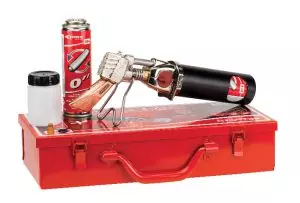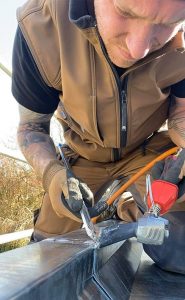
A zinc gutter is solid and aesthetically pleasing, but it must be maintained to ensure that it is perfectly watertight. For installation, fixing the gutter stop or repairing a leak, you will use a roofer’s soldering iron and tin solder.
You can do this work yourself, by choosing the right tool for the job: a professional soldering iron. Be careful, however, your repair will only be possible if the gutter is not too badly damaged. If your guttering is too damaged with many hole that form a kind of fine lace pattern, you will not have enough material to repair and should instead consider replacing your gutters.
Preparation tips
Every good zinc worker operates in impeccably clean conditions. You must only solder onto spotless surfaces and the sanding of the surface plays an essential role in keeping the parts you are going to weld clean.
Paint remover is used to remove the oxidation and rust that occur on metals in contact with the elements. The paint stripper also prepares the surfaces for better spreading of the solder metal on the parts to be joined. The solder must also, of course, be fluid and workable.
There are several types of paint strippers that come in liquid, powder, paste or solid form. You can choose between hydrochloric (muriatic) acid, ammonia salts, borax, resins, zinc chloride, decomposed hydrochloric acid or even aqua regia.
Hydrochloric acid is often used in a method called “spirit of salt sanding”.
Which soldering iron for the installation and repair of your zinc guttering?
The gas-powered roofing soldering iron is your best ally to repair your zinc guttering. You can use a portable soldering iron with a built-in gas bottle, as gutter access is not always practical.

Stand-alone metal iron roofing case
Choose a professional roofing iron where you can easily control the temperature. Depending on the cold and the wind, you must be able to modulate it so that it is perfect for welding. You must be able to control the gas flow. Be careful not to leave any traces of moisture on the parts to be joined, as this could cause the soldering points to break.
Your solder tip must be large enough and above all, always impeccably clean. You should use an ammonia stone as often as necessary to keep your tip in “tip-top” condition. It eliminates the traces of oxidation that form on the tip and affect the soldering.
How to solder your zinc gutter
Once your soldering iron is turned on, wait until the soldering tip is hot enough for the tin bolt that you use as a filler metal to become liquid and flow. Press hard to make weld points along the entire joint.
You can then move on to the second stage of the soldering process by sliding the soldering tip over the entire joint until it smoothes and forms a tidy line. The solder will therefore infiltrate by capillary action. The quality of a weld does not depend on the quantity of filler metal, but on the capillary penetration and its adhesion to the parts to be joined.
The third and final step is to make a barred joint to create reinforcements that come at right angles, over a width of 40 to 50 mm.
The installation of the gutter stop
To close the end of your guttering, using a prefabricated stop, cut your zinc guttering with a nibbling shear – this is preferable to a hacksaw which can deform the profile. Deburr the edges of the gutter with a soft file before fitting the stop. Strip the surfaces and proceed with the soldering of the zinc with tin. When you are finished working, it is crucial to never plunge your solder iron into cold water to cool it down, you risk damaging specifically the grill but also the iron in general.

